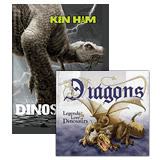
Canadian Amber Holds Fuzzy Fossils
Canadian amber preserves some itsy-bitsy fuzzy fossils.
News Source
- Science: “‘Dinofuzz’ Found in Canadian Amber”
Both dinosaur and bird feathers revealing the stages of feather evolution have been found in Canadian amber, according to a report published in Science. The amber tid-bits, most less than a centimeter across, are leftovers from the “Late Cretaceous” Grassy Lake coal bed in Alberta, Canada. Paleontology graduate student1 Ryan McKellar surveyed 4000 pieces of amber and found eleven with feathery, hairy, or fuzzy inclusions.
Many evolutionists are convinced that dinosaurs evolved into birds and that some dinosaurs had feathers. Chinese fossils purported to be feathered dinosaurs have included the Sinosauropteryx with some flattened fuzz deemed by some experts to be mere collagen fibrils, the Sinornithosaurus with similar filaments in tufts but no secondary branching or hooks, and the Anchiornis with mature bird feathers similar to those on another famous bird, the Archaeopteryx. Yet between the so-called “protofeathers” on actual dinosaur fossils and the mature feathers seen on Anchiornis and other fossilized birds, evolutionists have been unable to document any evolutionary progression.
Since several sorts of fuzzy morphology appeared in the amber and the amber all came from a Late Cretaceous coal bed dated by evolutionists at about 70 Ma2—McKellar asserts that “numerous evolutionary stages were present”3 at the same time. He writes, “These fossils have disparate morphologies that span four evolutionary stages.”4 These stages are described by the “currently accepted evolutionary-developmental model for feathers.”5
“We're catching some that look to be dinosaur feathers and another set that are pretty much dead ringers for modern birds.”
“We've got feathers that look to be little filamentous hair-like feathers, we've got the same filaments bound together in clumps, and then we've got a series that are for all intents and purposes identical to modern feathers,” McKellar said. “We're catching some that look to be dinosaur feathers and another set that are pretty much dead ringers for modern birds.”6
The specimens resembling “stage I” and “stage II” of the hypothetical evolutionary model are simply filaments without any of the defining features of feathers. The filaments do not appear to be of plant, fungal, or mammalian origin as they have neither cell walls nor the small scales typical of mammal hair. McKellar explains, “We don't absolutely know what they are, but we're pretty sure what they're not.”7
The hollow, regularly spaced “stage I” filaments are reminiscent of the ”protofeathers” on Sinosauropteryx, although the amber specimens are significantly finer in caliber.8 The “stage II” filaments seem to be clustered in tufts but have no rachis or hooklets as feathers do. They most closely resemble the “protofeathers” associated with Sinornithosaurus, although the amber specimens lack the apparent organizational bundling observed on the Sinornithosaurus.9
The other “evolutionary” feather stages represented in the amber are parts of mature feathers commonly seen in modern flying birds and in modern diving birds. The latter have well-preserved whorls at the barbule bases, a feature which soaks up water to improve hydrodynamic efficiency. The modern-appearing flight feather parts include the same parts seen in feathers today—rachis, differentiated barbules on thick rami, interlocking barbules. Pigmentation of the modern-appearing feathers is also consistent with what we see today—“everything from white downy feathers to other birdlike feathers with grey or brown colours as well.”10
Significantly, despite the alleged resemblance to “protofeathers,” none of the amber specimens contain any other portions of their original owners. Therefore it is impossible to be sure what animals any specimens belonged to. The article in Science states, “Neither avian nor dinosaurian skeletal material has been found in direct association with amber at the Grassy Lake locality. . . . There is currently no way to refer the feathers in amber with certainty to either birds or the rare small theropods from the area.”11 Yale evolutionary ornithologist Richard Prum notes, “The lack of any other remains in the amber—a distinctive bit of bone, say, or a shred of skin—leaves open the possibility that the structures aren't associated with dinosaurs at all.”12
The presently popular though far from unanimous view among evolutionists today is well-expressed by paleontologist Mark Norell, who wrote a Science commentary on McKellar’s research. He says, “We've known for quite a while that several of the non-bird dinosaurs actually had feathers and many of them had feathers that are identical to the feathers you see on a pigeon in the park today.”13 Of course, finding those mature feathers on dinosaurs requires redefining obvious birds as dinosaurs. If the discoverer of these bits of amber did not have implicit faith in the evolutionary worldview and the evolutionary model of feather evolution, he may have been less ready to match his simpler filaments to the evolutionary model and the nearest possible “protofeathers.”
Multiple modern bird feather designs were present—some even entangled with spider web10—but no dino-presence was detectable.
Despite the ambitious title of McKellar’s article, ”A Diverse Assemblage of Late Cretaceous Dinosaur and Bird Feathers from Canadian Amber,” there is actually no evidence linking these pieces of amber with dinosaurs. Multiple modern bird feather designs were present—some even entangled with spider web14—but no dino-presence was detectable. The researcher needed to see evolving feathers, so he chose the nearest available dino-fuzz—a fossilized impression not universally accepted as feathers even among expert evolutionary ornithologists and paleontologists. Perhaps the filaments are similar to filoplumes, tiny filamentous feathers which probably function as mechanoreceptors in modern birds, or perhaps as Richard Prum suggests, “They could be something completely new that hasn't been preserved elsewhere in the fossil record.”15 But to assert that dinosaur feathers have been found in amber is a headliner without substance.
Evolutionists since Darwin have desperately needed evidence that feathers evolved from something. Darwin himself commented, “The sight of a feather in a peacock’s tail, whenever I gaze at it, makes me sick!”16 Norell explains that Darwin’s dilemma stemmed from the fact that the “earliest and most primitive feathers found in association with Archaeopteryx were already of modern aspect.”17 He believes McKellar’s amber inclusions have put that dilemma to rest by proving that “primitive and advanced feather morphologies” could coexist.18 But without proof that these simpler structures are genuine feather parts and that they belonged to dinosaurs, McKellar’s amber has proven no such thing.
Creationist researchers can confidently declare that since the Bible in Genesis 1 teaches that birds were created before land animals like dinosaurs, the evolutionary story of birds appearing after the dinosaurs is wrong. The fossil record, when properly interpreted, confirms the Genesis account.
Further Reading
For More Information: Get Answers
Remember, if you see a news story that might merit some attention, let us know about it! (Note: if the story originates from the Associated Press, FOX News, MSNBC, the New York Times, or another major national media outlet, we will most likely have already heard about it.) And thanks to all of our readers who have submitted great news tips to us. If you didn’t catch all the latest News to Know, why not take a look to see what you’ve missed?
(Please note that links will take you directly to the source. Answers in Genesis is not responsible for content on the websites to which we refer. For more information, please see our Privacy Policy.)
Footnotes
- “Amber Reveals Dinosaur, Bird Feathers,” CNN, September 16, 2011, http://lightyears.blogs.cnn.com/2011/09/16/amber-reveals-dinosaur-bird-feathers.
- Norell, M. A., “Fossilized Feathers,” Science 333, no. 6049 (September 16, 2011): 1590–1591, doi:10.1126/science.1212049.
- Ibid.
- McKellar, R. C., B. D. E. Chatterton, A. P. Wolfe, P. J. Currie. “A Diverse Assemblage of Late Cretaceous Dinosaur and Bird Feathers from Canadian Amber,” Science 333, no. 6049 (September 16, 2011): 1619–1622, doi:10.1126/science.1203344.
- Ibid.
- “Dinosaur Feather Evolution Trapped in Canadian Amber,” BBC News, September 15, 2011, http://www.bbc.co.uk/news/science-environment-14933298.
- Perkins, S., “‘Dinofuzz’ Found in Canadian Amber,” Science, September 15, 2011, http://www.sciencemag.org/news/2011/09/dinofuzz-found-canadian-amber.
- McKellar et al., “A Diverse Assemblage.”
- Ibid.
- “Amber Reveals Feathered Dinosaurs, Birds Shared Habitat,” CTV News, September 15, 2011, http://www.ctv.ca/CTVNews/SciTech/20110915/amber-feathered-dinosaurs-110915.
- McKellar et al., “A Diverse Assemblage.”
- Perkins, “‘Dinofuzz.’”
- “Dinosaur Feather Evolution.
- CTV News, “Amber Reveals.”
- BBC News, “Dinosaur Feather Evolution.”
- Norell, “Fossilized Feathers.”
- Ibid.
- Ibid.
Recommended Resources

Answers in Genesis is an apologetics ministry, dedicated to helping Christians defend their faith and proclaim the good news of Jesus Christ.
- Customer Service 800.778.3390
- © 2024 Answers in Genesis





